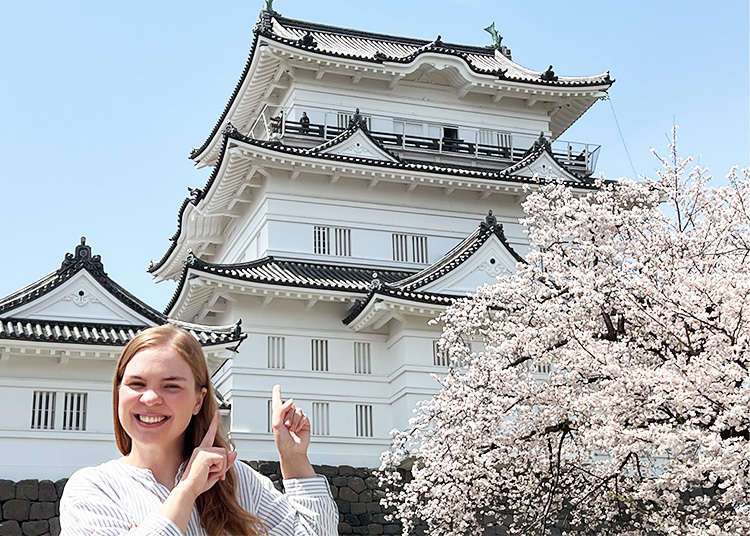
Half-Day Getaway from Tokyo: Cherry Blossoms, Local Culture and Samurai Vibes at Odawara Castle
- Written by: LIVE JAPAN Editor
Just a short train ride from Tokyo, Odawara Castle offers a breathtaking view year-round—but it’s especially magical in spring, when the sakura trees surrounding the castle burst into full bloom. Known for its rich history and deep connection to Japan’s samurai legacy, the castle becomes a popular hanami destination.
LIVE JAPAN editors Johanna and Lee made their way down to the castle to experience the area in peak bloom—and to explore what makes this spot so special during sakura season.
(This article may contain promotions)
- Table of Contents
What is Odawara Castle?
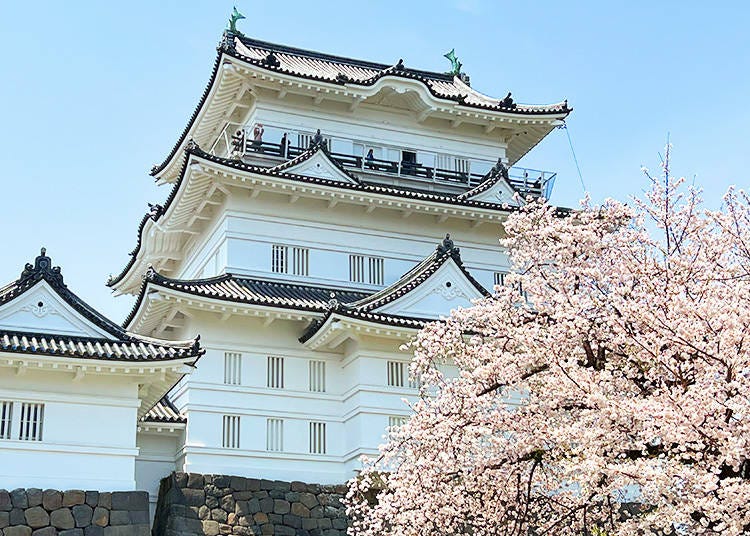
Odawara Castle, a historic landmark in Kanagawa Prefecture, dates back to the 15th century and once served as the stronghold of the Hojo clan during Japan’s Sengoku period (1467–1590). The original structure was destroyed by an earthquake in 1703 and later dismantled during the Meiji Restoration.
Reconstructed in 1960, the castle now stands surrounded by moats and cherry trees, offering especially beautiful views during the cherry blossom season. From the top floor, visitors can enjoy sweeping views of the region and ocean, while the interior showcases samurai culture and historical artifacts—making it a must-visit spot just a short trip from Tokyo.
Getting to Odawara Castle
Odawara is just a short trip from central Tokyo, making it an ideal destination for a day trip. It's about a 10- to 15-minute walk from Odawara Station. Also consider a visit if you're planning a trip to Hakone, as the castle is conveniently located nearby.
From Tokyo Station
- Take the Tokaido Shinkansen (Kodama or Hikari)
- Duration: 33 minutes
- Fee: 3,280 yen
- Covered under: Japan Rail Pass
- Take the JR Tokaido Line (Rapid)
- Duration: Approx. 1 hour 25 minutes
- Fee: 1,520 yen
- Covered under: JR Tokyo Wide Pass
From Shinjuku Station
- Take the Odakyu Romancecar
- Duration: Approx. 1 hour 15 minutes
- Fee: 2,470 yen (including seat reservation)
Visiting Odawara Castle in Spring
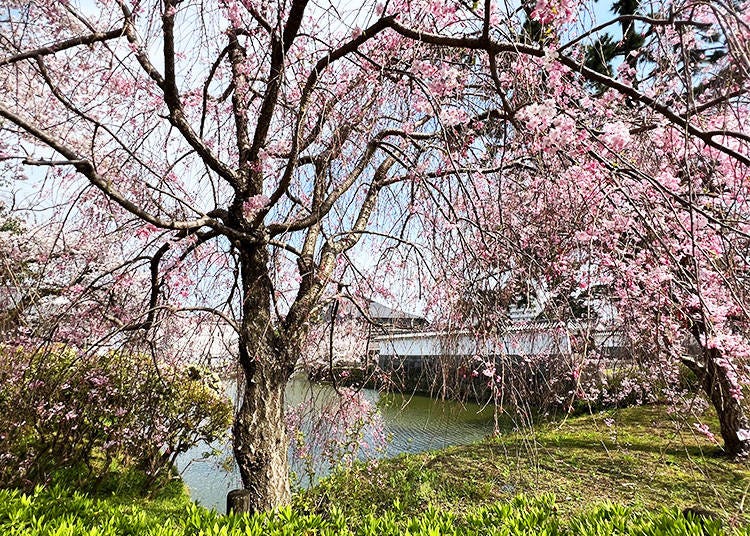
Odawara Castle Park is home to approximately 300 cherry blossom trees, primarily of the Somei Yoshino variety. These trees bloom around the castle ruins and its surroundings, creating a picturesque scene during the cherry blossom season.
The Odawara Castle during cherry blossom season does not feature any spectacular events, stage performances or exhibitions. While you’ll find a couple of food stalls positioned in front of the castle, most visitors enjoy the festival by simply pulling out picnic sheets and an array of sweet treats, to spend some time under the beautiful trees. Hanami (flower viewing) with Odawara Castle as a backdrop is enough to make lovely spring memories.
Traditional Cultural Events at Odawara Castle
The Kamaboko Festival is held annually at the end of March on the Odawara Castle grounds, and celebrates the region's history of producing “kamaboko”, a traditional Japanese fish cake. During the festival, visitors can enjoy a variety of kamaboko-themed events, including tastings, performances, and hands-on experiences related to this beloved local delicacy.
The 2025 Odawara Kamaboko Sakura Festival was held between March 29-30, from 10 AM to 5 PM each day.
Recommended Cherry Blossom Spots around Odawara Castle
Odawara Castle Ruins Park
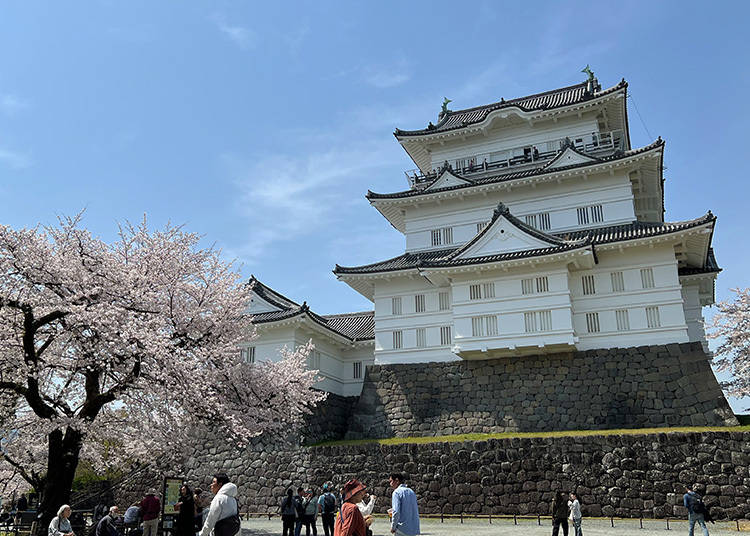
Odawara Castle Ruins Park surrounds the historic castle grounds with beautifully landscaped paths, seasonal flowers, and views of the main keep. Especially popular in spring, the park transforms into a beloved cherry blossom spot, drawing visitors who come to stroll beneath the blooming trees and snap pictures of the pink flowers with the scenic castle in the background.
Definitely consider bringing a picnic sheet and something sweet to snack on—or why not grab a piece to eat from one of the food stalls positioned across from the castle during the season.
Around the Moat
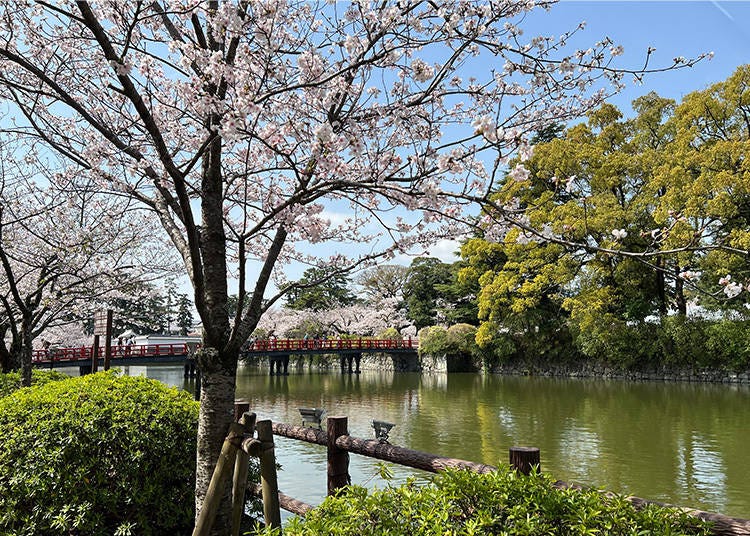
The cherry blossoms reflect beautifully in the water when you walk around the moat, both outside and inside the castle grounds.
Around the Castle Gates
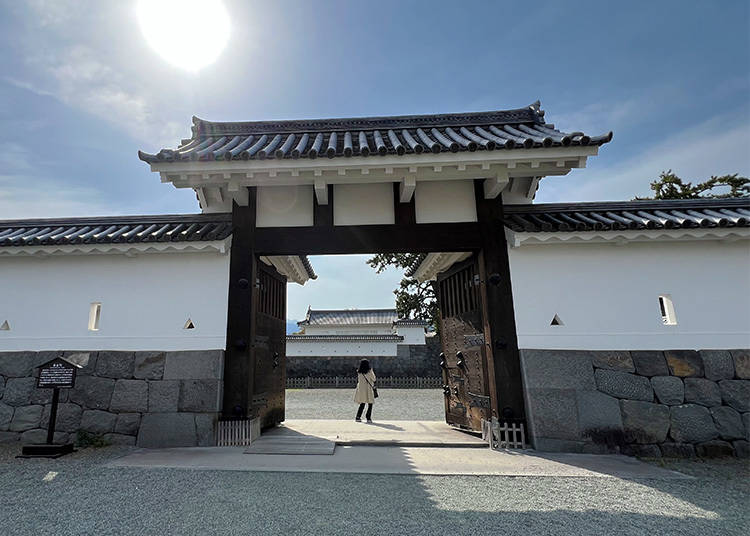
The Umadashi-mon Gate serves as the main entrance to Odawara Castle and is located to the northwest of the castle grounds. Visitors approaching from Odawara Station's East Exit typically walk along Ohoribata Street, leading them directly to this gate.
It opens onto a square masugata court, a defensive feature designed to delay attackers. From there, you will start to see a hint of pink peaking out from the castle park.
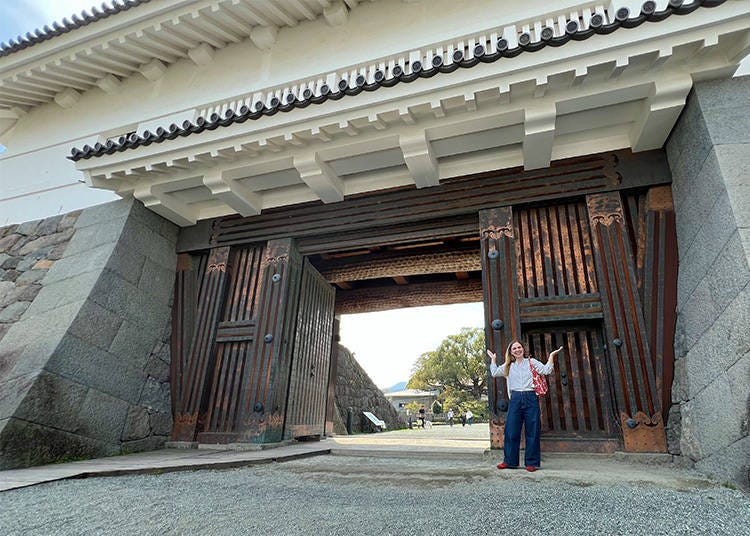
Reconstructed in 1997, the Akagane-mon Gate is named for the copper fittings on its large wooden doors. The gate leads into a spacious courtyard once serving as a defensive zone, now transformed into a scenic pathway with gardens and access to other significant parts of the castle grounds.
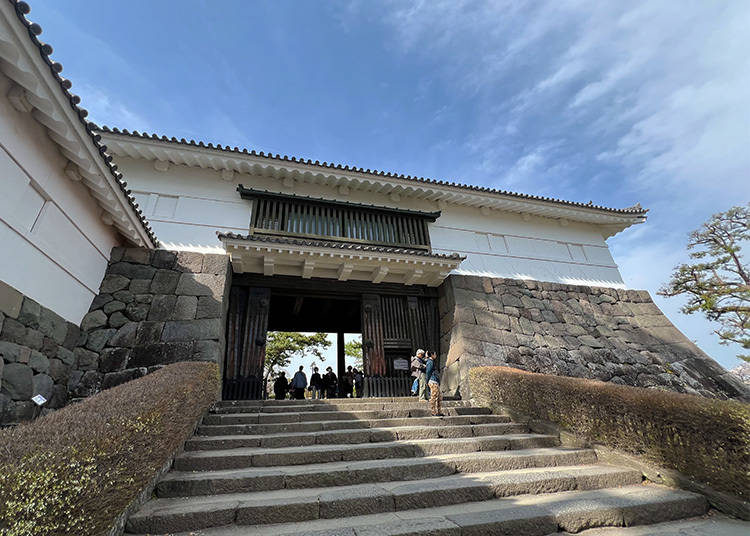
Tokiwagi-mon Gate is the main gate of the Honmaru (central bailey) and serves as the primary entrance to the castle. Reconstructed in 1971, it is named after the nearby evergreen pine trees, symbolizing longevity and prosperity for the castle. In spring, you will be met by a row of beautiful cherry blossom trees surrounding the main keep.
Highlights Inside Odawara Castle
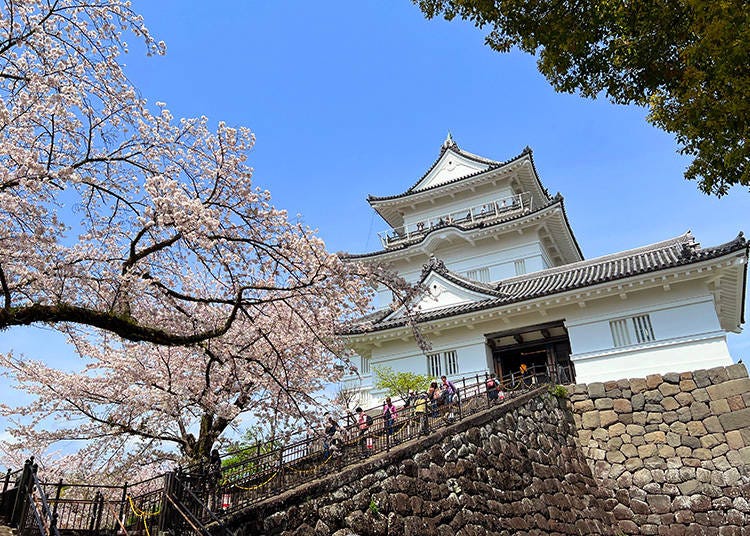
What would a visit to Odawara Castle be without a visit to—well—the castle! The main keep is one of the highlights of the area; a reconstructed five-story tower that offers panoramic views of Odawara City and Sagami Bay from its top floor.
Inside, the keep houses exhibits on samurai culture and the castle's history through infographics, art and well-kept artifacts from times past. Before exiting the main keep, you will pass through a gift shop with thematic souvenirs—definitely worth a stop by to have a look around!
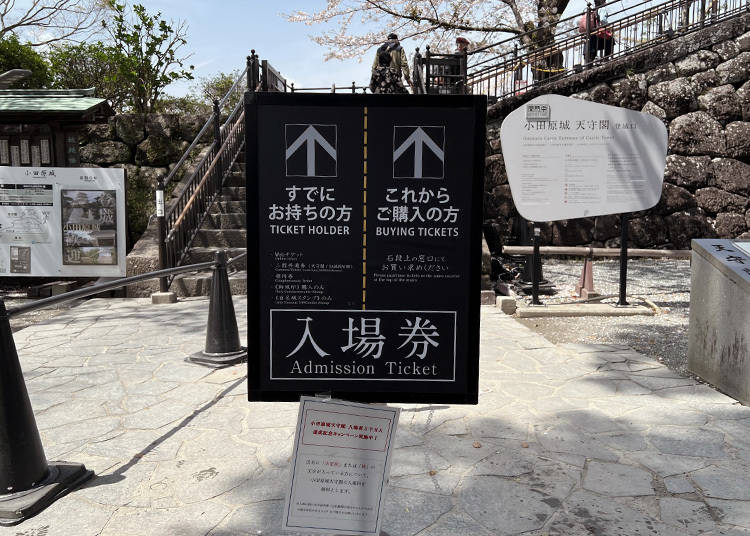
Admission to the main keep is 510 yen for adults and 200 yen for elementary and junior high school students. Tickets can be bought online ahead of time or at the counter to the right of the entrance above the stairs.
Our editors took the chance to check out the main keep, let’s have a look!
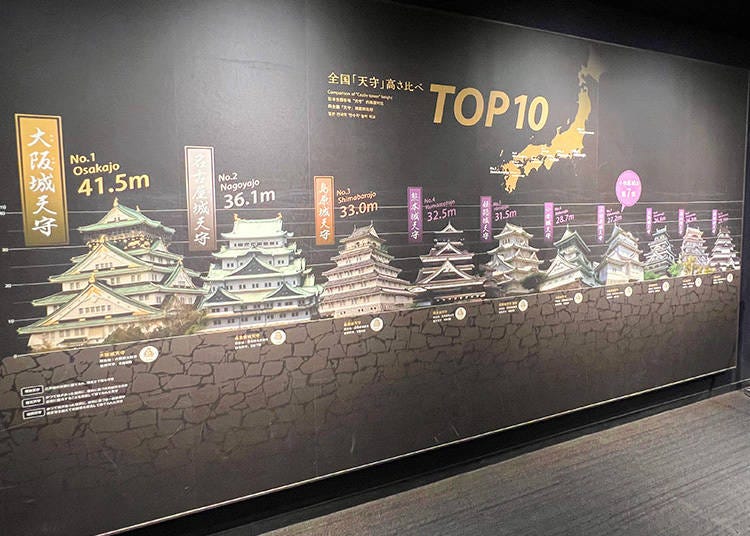
At the very start of the exhibition, we found a graphic introducing the Top 10 tallest castle towers of Japan (counting from their stone base). Osaka Castle comes out on top with an impressive 41.5m, followed by Nagoya Castle at 36.1m and Shimabara Castle (Nagasaki) at 33.0m.
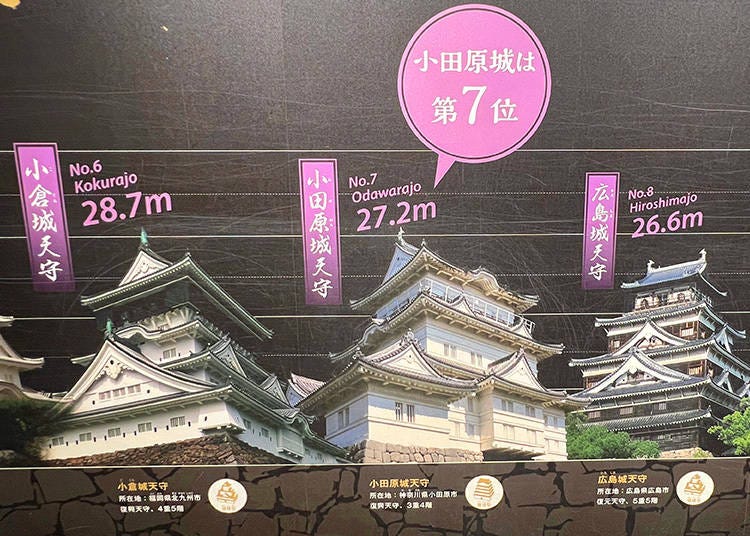
Odawara Castle sits at 7th place, right in between Kokura Castle (Fukuoka) at 28.7m and Hiroshima Castle at 26.6m.
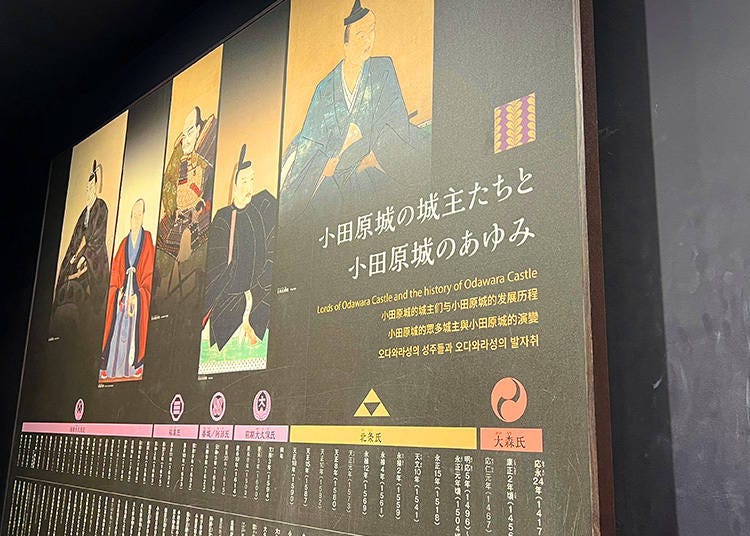
The first floor of the main keep focuses on the role of Odawara Castle during the Edo period, especially its role as a defensive stronghold for the western region of Edo. It also introduces the history of the castle's lords.
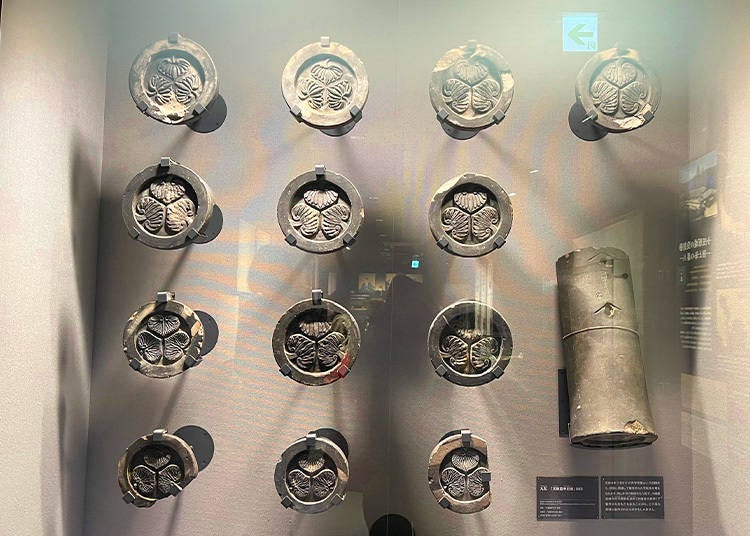
A glimpse into the dramatic history of Odawara Castle. After the Hojo clan's defeat in the Siege of Odawara in 1590, Odawara Castle came under the control of the Tokugawa clan. The Tokugawa clan took control of the castle in the early 17th century, and made significant renovations to its structure, including the use of the Mitsuba Aoi-mon roof tiles as a symbol of their authority.
The second floor of the main keep highlights the Sengoku period and the history of the Hojo clan, who made Odawara Castle their base of operations during this time.
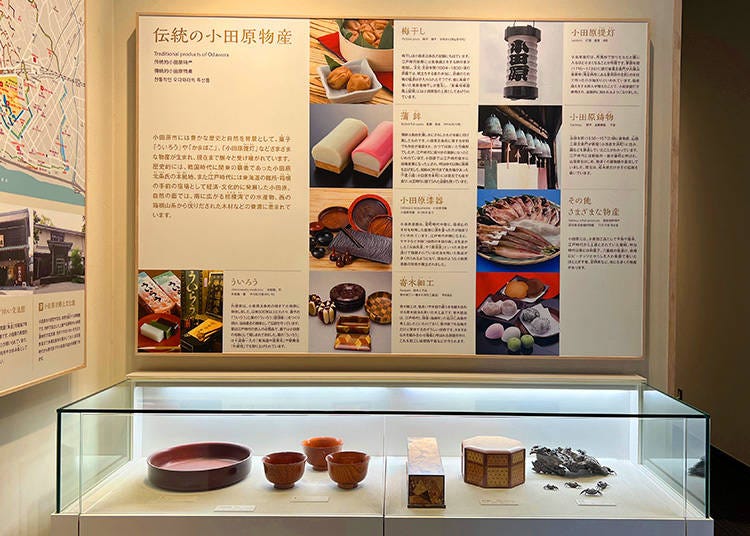
The third floor highlights and displays artworks and crafts related to Odawara, as well as findings from archaeological excavations at the castle. You will find items such as Odawara shikki (lacquerware), Odawara senbei (rice crackers), and Odawara umeboshi (pickled plums), reflecting the region's rich cultural heritage.
The exhibit also highlights archaeological findings from the castle's grounds, offering insights into the daily lives and traditions of its past inhabitants.
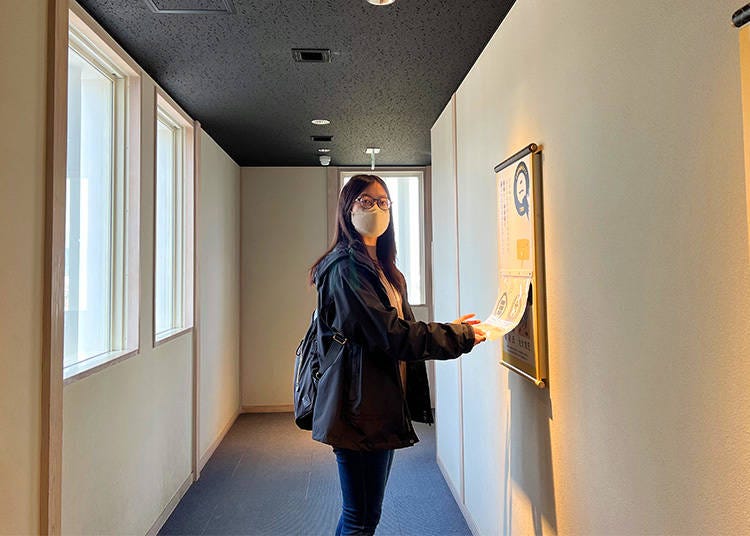
On the same floor, visitors can enjoy a fun and interactive quiz corner built into the exhibition walls, perfect for families and children. Each panel invites you to guess the answer to a history or culture-related question, then lift the flap to see if you're right.
The quizzes are written in Japanese, so if you’re confident in your language skills and history knowledge, it’s a great chance to put them to the test!
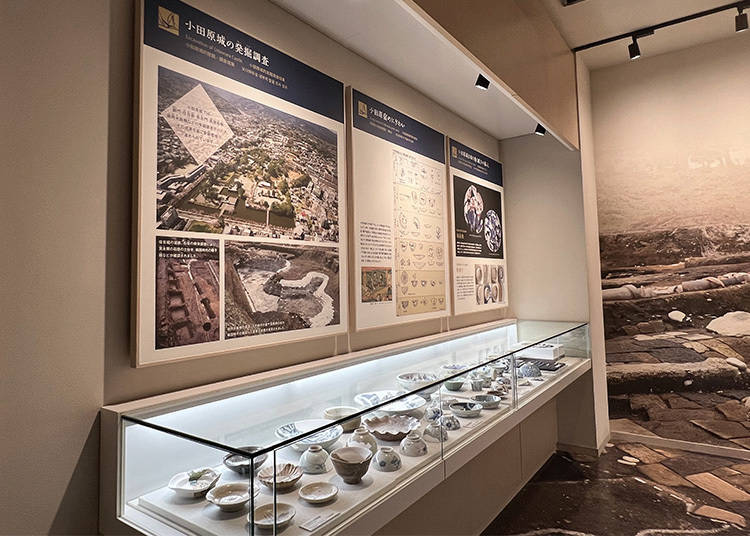
The fourth floor highlights Odawara Castle’s journey from the Meiji period to the present, including its dismantling after the castle’s abolition in 1870, damage from the 1923 Great Kanto Earthquake, and the many restoration efforts over the years, leading up to the 2016 renovation that added earthquake-resistant features to the main keep.
(Please note that this exhibition’s contents may change depending on the time of year.)
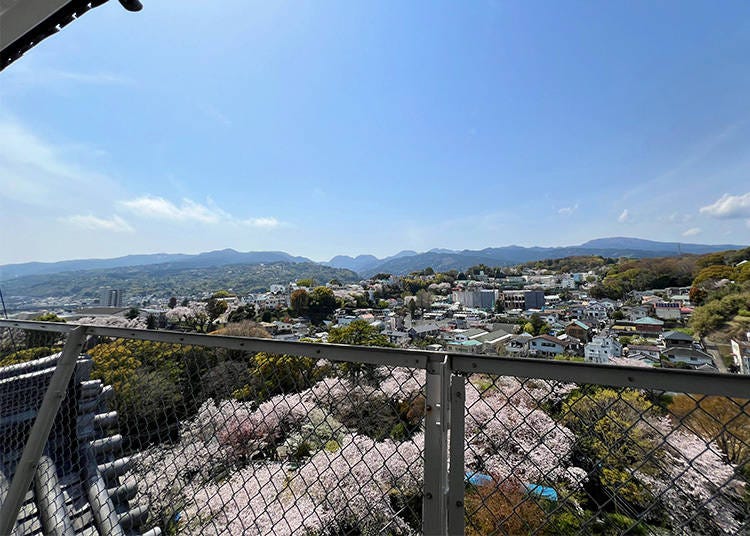
On the fifth floor of the main keep, visitors can head out to the observation deck. This highlight of the keep offers stunning views of Odawara City, Sagami Bay, and, on clear days, the Izu Peninsula and Hakone mountains.
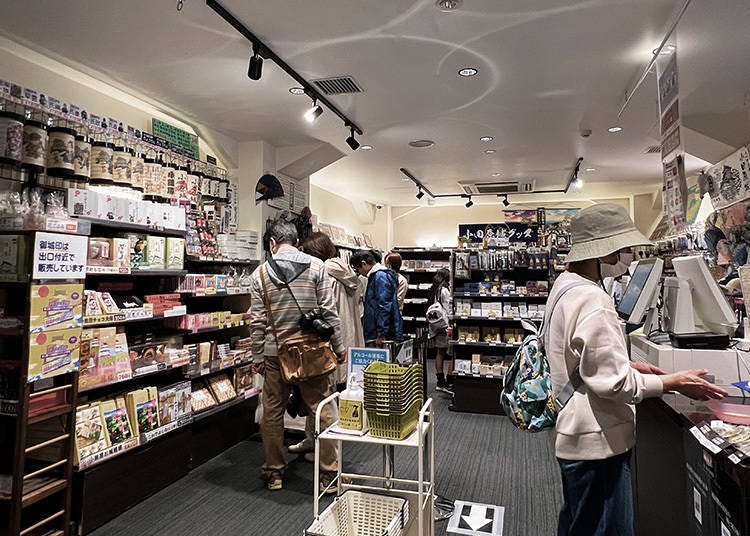
Before exiting the main keep, visitors will be led down the stairs to a gift shop. You will find a selection of local souvenirs and traditional crafts, making it a great spot to pick up a memento of your visit! You can choose from items such as castle-themed goods, traditional Japanese crafts, and local specialties that reflect the region's rich heritage.
The shop accepts cash, credit cards, and other common payment methods.
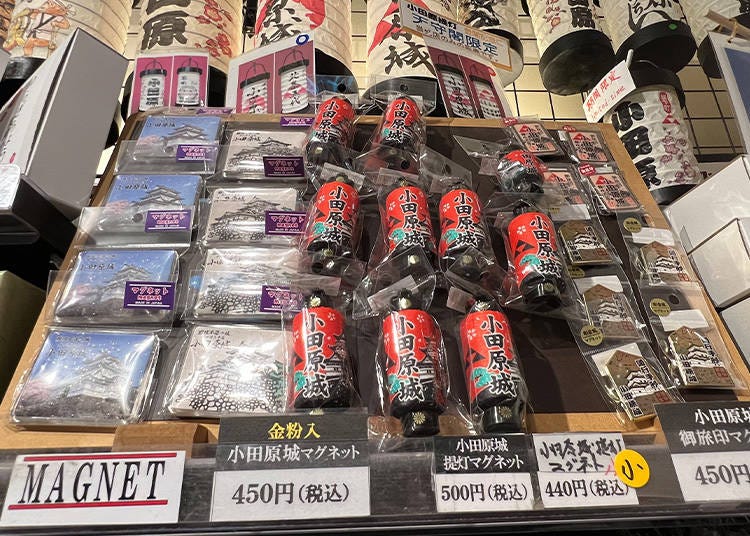
As the clerk pointed out, castle-themed magnets are a top choice for international visitors. They come in various designs and shapes, making them a perfect memento to take home.
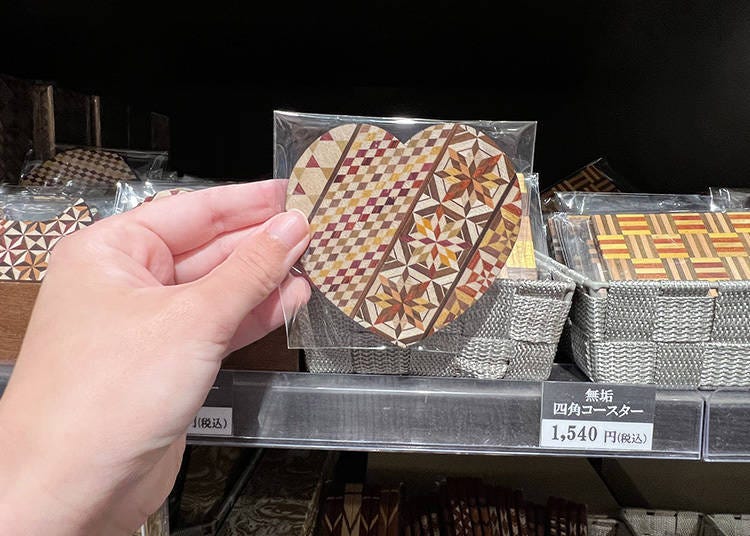
Editor Johanna fell for this beautiful coaster, crafted using the traditional Hakone yosegi-zaiku technique, a type of Japanese wood mosaic from the nearby Hakone region. This craft involves carefully arranging thin wooden pieces, often cedar, to create geometric patterns that highlight the natural beauty of the wood.
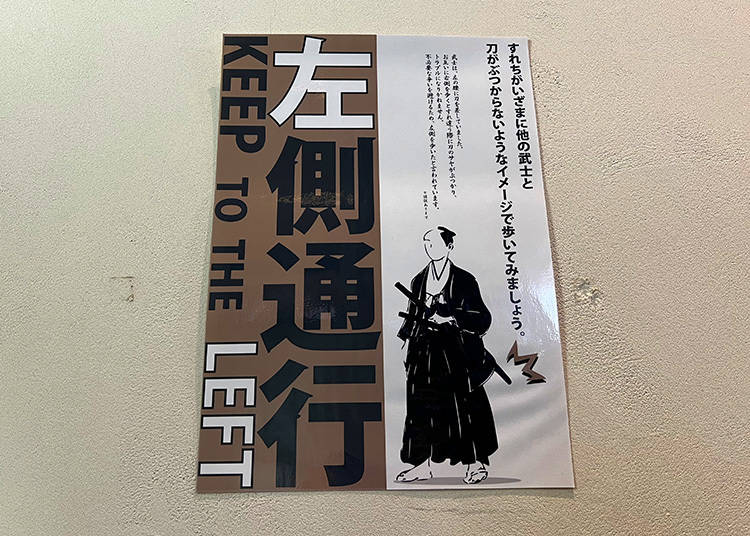
“Keep to the left!”
Walking up and down the stairs, you might notice this sign plastered on the walls asking visitors to keep to the left while walking around inside, with an image of a samurai holding his sword. This reflects a traditional practice in Japan during the feudal era, where individuals were advised to walk on the left side to avoid the risk of their swords—worn on the left side—hitting others when passing, which could cause unnecessary conflict.
Odawara Castle’s main keep lets you learn about and enjoy samurai culture in all sorts of ways!
- Admission:
Odawara Castle (Main Keep)
- Adults 510 yen
- Children (Elementary/Junior High) 200 yen
Combined Ticket (Castle + Samurai Museum)
- Adults: 610 yen
- Children: 220 yen - Closed: December 31 - January 1, 2nd Wednesday of December (closed for maintenance)
- *Tickets can be purchased online or at the counter. Please refer to the official website for details.
-

-
Address
6-1, Jonai, Odawara-shi, Kanagawa, 250-0014
View Map -
Nearest Station
Odawara Station (Tokaido Shinkansen Line / JR Tokaido Main Line / JR Shonan Shinjuku Line / JR Ueno Tokyo Line / Odakyu Odawara Line / Hakone Tozan Railway / Izuhakone Railway Daiyuzan Line)
10 minutes on foot
- Phone Number 0465-23-1373
-
Address
6-1, Jonai, Odawara-shi, Kanagawa, 250-0014
Lunch at Honmaru Chaya
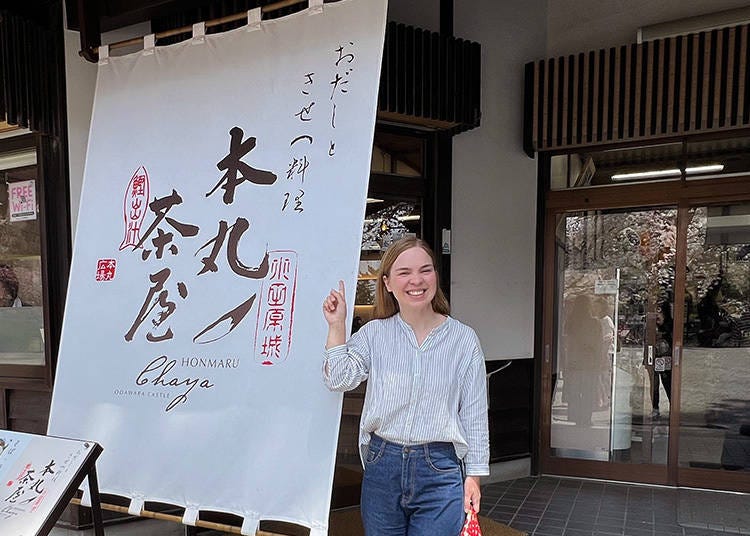
Odawara makes for a great half-day trip from Tokyo or Hakone, and we highly recommend grabbing a bite to eat while visiting the castle grounds. Right across from the main keep, you’ll find Honmaru Chaya, a charming eatery nestled within the castle park.
Offering visitors a blend of traditional Japanese cuisine and scenic views of the castle grounds, this is the perfect spot to stop by and grab a bite!
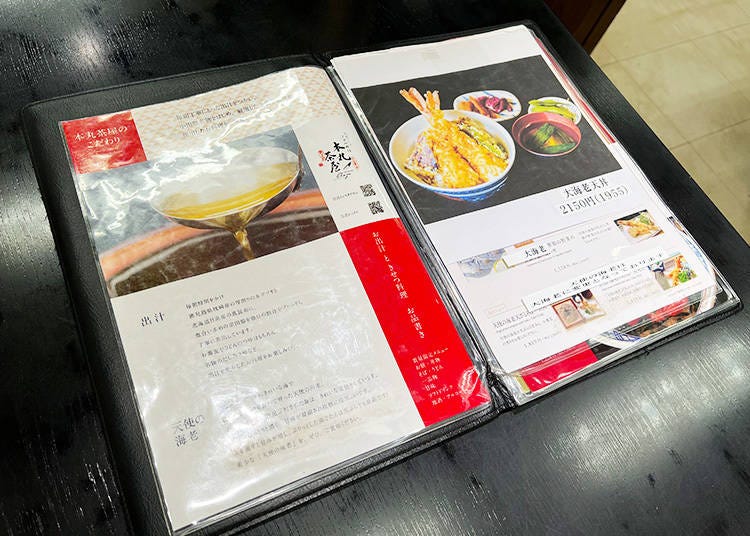
Honmaru Chaya serves a range of dishes including fresh seafood, noodle soups, and seasonal dishes. Their dashi broth is made daily from scratch, using a blend of katsuobushi (bonito flakes), kombu (kelp) and sodabushi (frigate mackerel flakes). This broth forms the base for their soba and udon dishes, as well as specialties like their signature dashimaki tamago.

By recommendation from the staff, we started off by trying the popular "Hojo Udon." The Hojo Udon pays homage to the Hojo clan—the powerful samurai family that ruled over the Odawara region during the Sengoku period—by incorporating umeboshi as a highlight in the dish.
Umeboshi is believed to represent resilience and strength, qualities that reflect the Hojo’s legacy as enduring leaders who withstood multiple sieges at Odawara Castle.
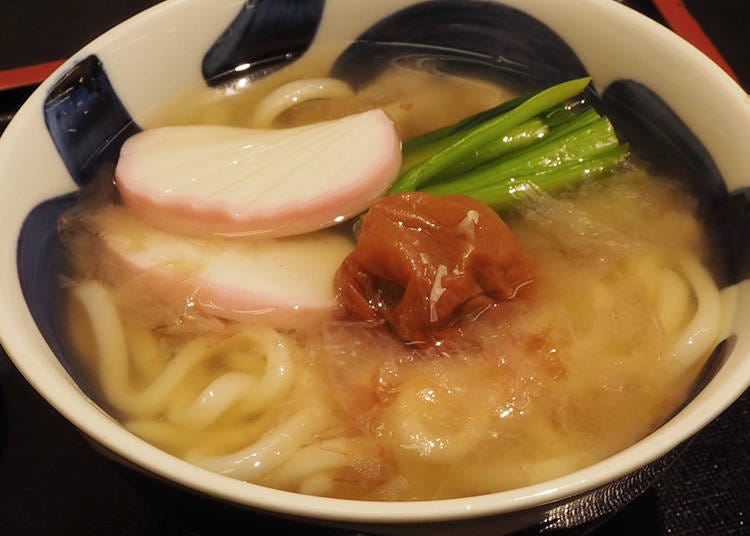
The staff instructed us to break the umeboshi apart with our chopsticks and blend it with the soup. This gave the Hojo Udon its signature flavor—a humble soup stock paired with the tanginess of the salty-and-sour plum. We shared a bowl on our visit, and slurped it up faster than a samurai charging into battle!
Let’s have a look at what else we tried on our visit.
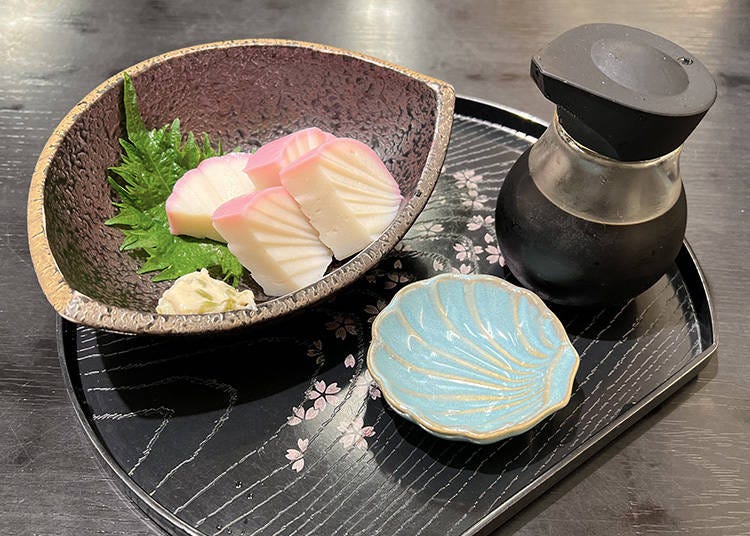
No visit to Odawara is complete without trying kamaboko, so we ordered a plate! This local specialty, made from fresh fish and steamed into a smooth cake, has been part of the region’s culinary heritage for centuries.
At Honmaru Chaya, we tried “Itawasa kamaboko”, served as thin slices on a wooden board with wasabi and soy sauce for a simple yet flavorful experience.
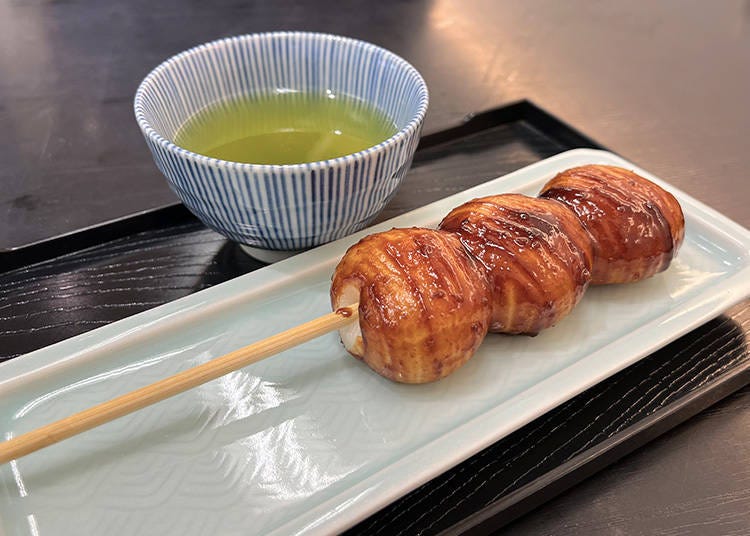
Another side dish we tried was this Hojo Dango—chewy rice flour dumplings—dipped in walnut miso. The strong miso balanced out well with the creamy walnut paste.
Accompanied with the dango came a cup of green tea, which is commonly served alongside traditional Japanese sweets as a palate cleanser. The bitterness of the tea is supposed to complement the sweetness or richness of the dish, and we found this combination to be quite lovely!
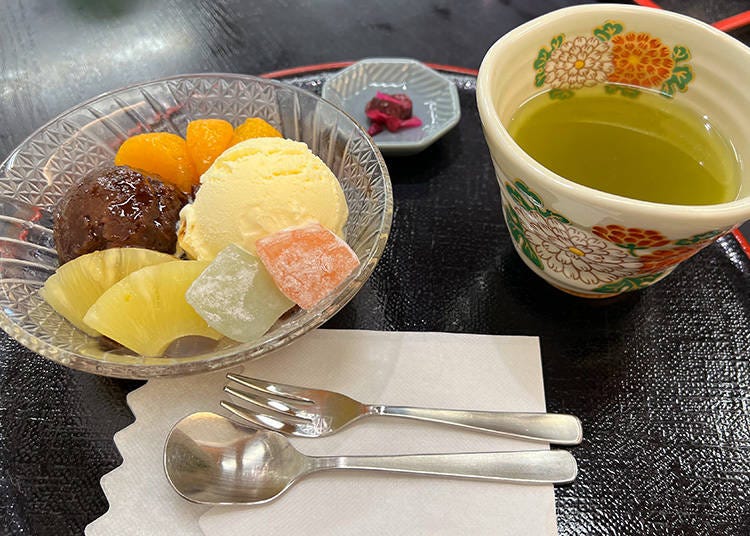
Dessert time! The staff recommended we try their Cream Anmitsu, a lovely bowl of fruits, vanilla ice cream, sweet red bean paste and agar jelly. The agar jelly and sweet red bean paste are made at Ayabe Seianjo, a long-established confectionery shop in Odawara.
As with the Hojo Dango, a cup of green tea came on the side. A few slices of tangy shibazuke pickles added a salty contrast as well. It might sound unusual, but we encourage you to give it a try—you might be surprised how well it all works together!

For a drink, we were recommended to try their amazake, a traditional sweet rice drink. With its creamy texture and subtle sweetness, it’s not for everyone, but it pairs perfectly with Japanese sweets like dango or anmitsu.
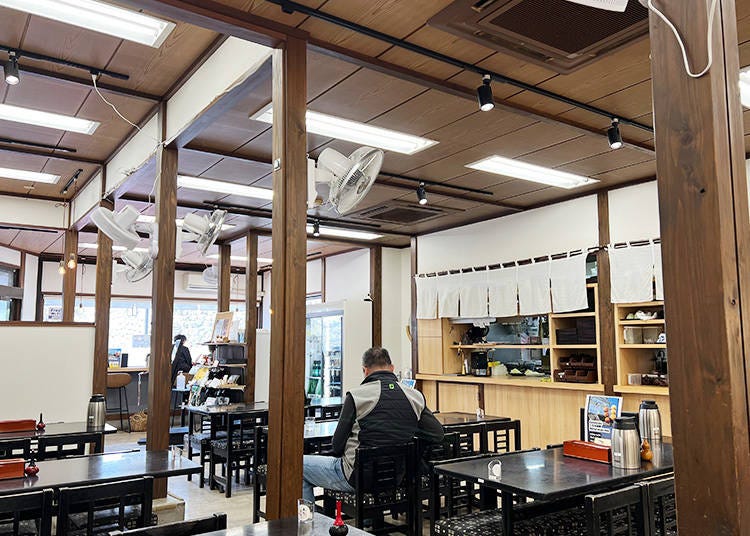
Large windows by the entrance provide views of the surrounding castle grounds, allowing guests to enjoy their meals while taking in the historical surroundings.
Honmaru Shop
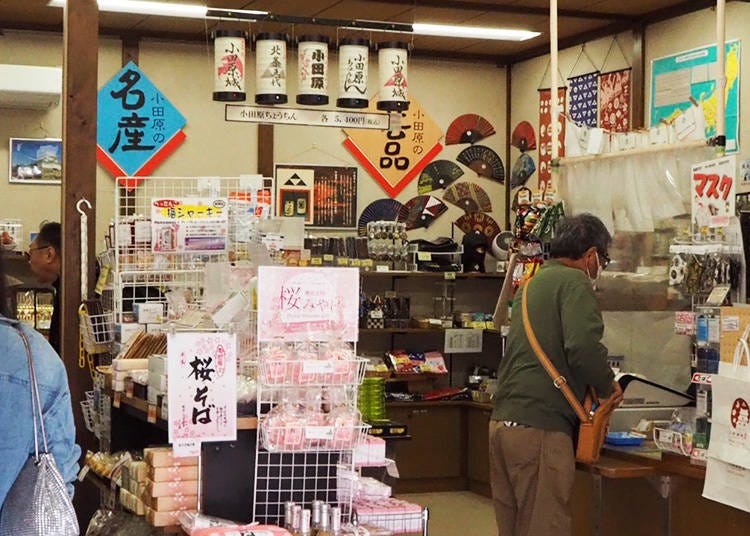
Just next door to Honmaru Chaya is the Honmaru Shop, a cozy boutique offering Odawara-themed souvenirs and locally made delicacies.
In spring, the shop features a selection of cherry blossom-inspired treats, including candies, rice crackers, and sakura soba—noodles infused with cherry blossom petals that give them a delicate floral flavor and soft pink color.
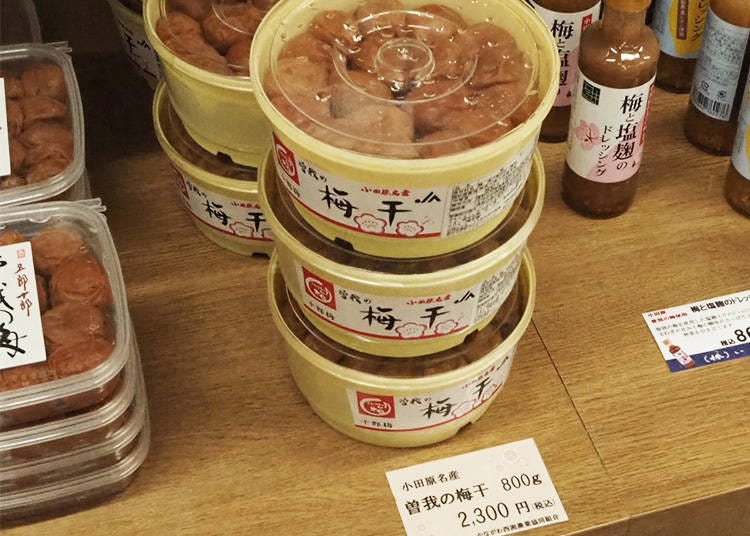
Pickled plums come in different varieties.
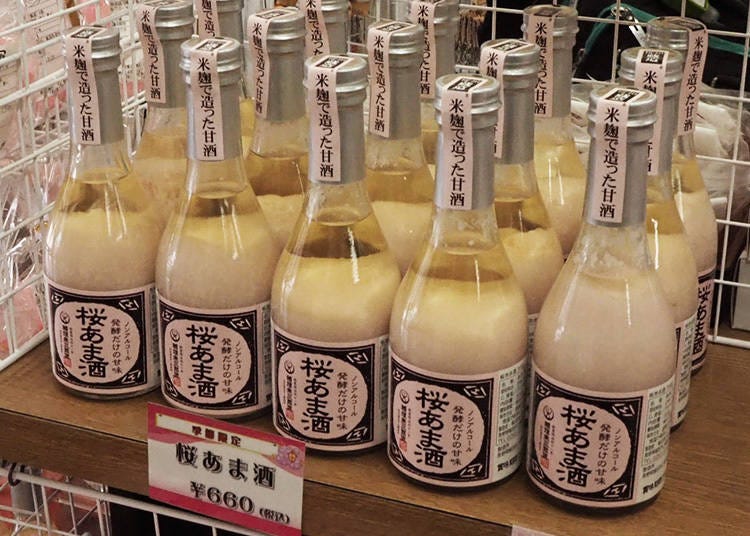
In spring, you can also pick up a bottle of Sakura Amazake from the Honmaru Shop. This limited-time seasonal drink is only available while supplies last.
-
Honmaru Chaya本丸茶屋
- Address Odawara City 6-1 Jonai Odawara Castle Park Honmaru Hiroba
Hours: 9 AM - 5 PM (L.O 4:30 PM)
Closed: Open year-round
*Honmaru Shop is closed between Dec 31 - Jan 1
Visiting the Samurai Museum
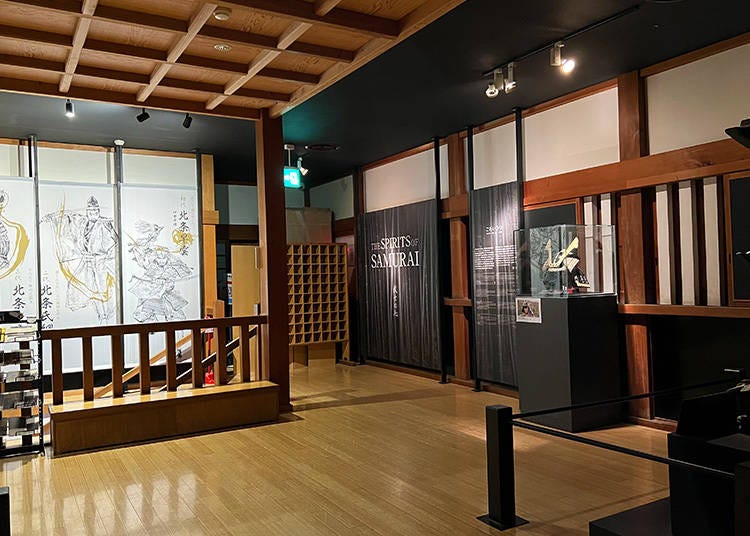
Samurai lovers and enthusiasts will be happy to find that Odawara Castle boasts its own Samurai Museum! Just steps away from the main keep, the Odawara Castle Samurai Museum offers a deeper look into the world of the samurai.
From authentic armor and weaponry to the chance to dress as a samurai, it’s a great stop for anyone curious about Japan’s warrior history—lots to enjoy for families and history lovers alike!
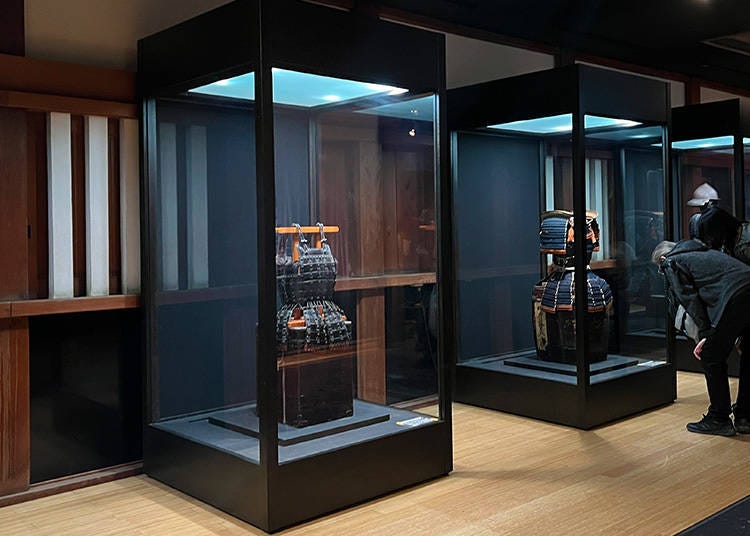
A thrilling insight into the samurai culture of years past.
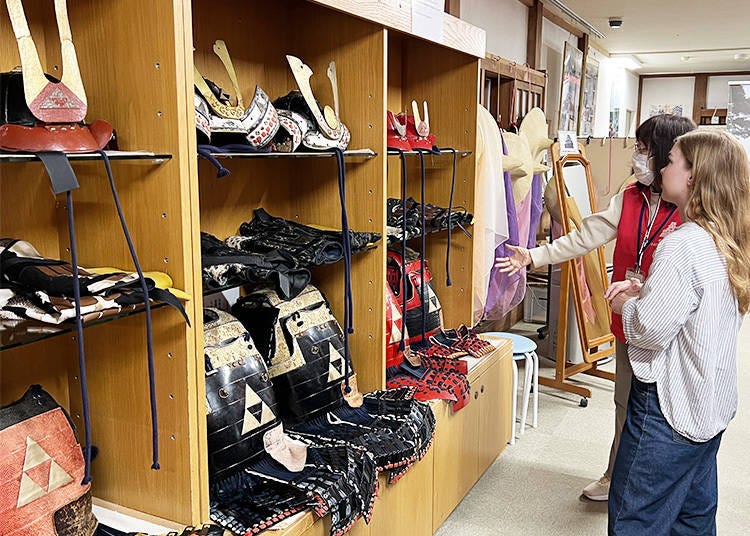
On the first floor of the Samurai Museum, both children and adults get the chance to jump back in time! The museum offers a dress-up experience (500 yen), where visitors can choose between a ninja, princess (kimono), or samurai attire to put on and stroll around the castle grounds.
Our editor Johanna had already decided her attire, way back in the planning stages of this visit. She wanted to be a samurai!

After picking her armor of choice, the kind staff asked her to sit on a stool to get dressed. The staff carefully brought out one piece of the armor at the time, starting with leg covers, arm covers, chest armor, and finally the helmet. The armor was surprisingly heavy - the helmet alone weighed around 2.5 kilograms!
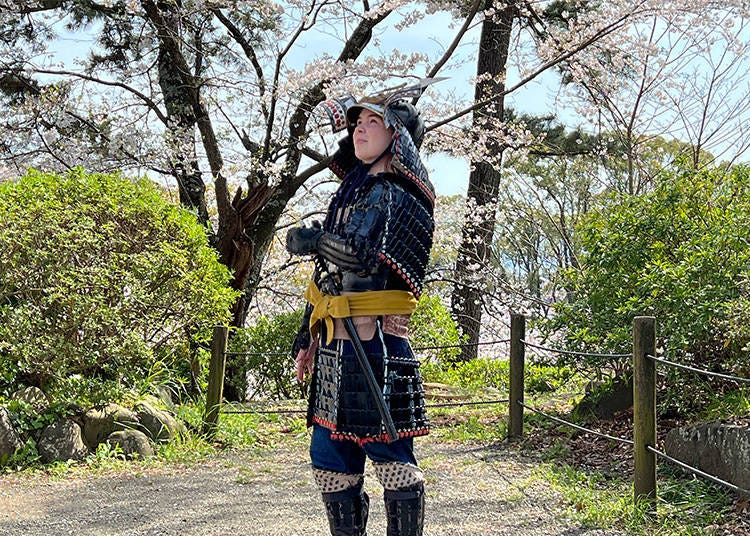
After completing the dressing, feel free to roam the castle grounds feeling like a... well, a samurai! Or a ninja or princess, of course, if that is your costume of choice. Consider taking a few memorable pictures around the grounds, perhaps with some cherry blossoms in the background—or why not a stunning backdrop of the main keep.
Just keep in mind that you cannot enter the main keep or leave the castle grounds while wearing your costume.
- Hours: 9 AM - 5 PM (Last entrance at 4:30 PM)
- Admission:
SAMURAI Museum Admission Only
- Adults: 200 yen
- Children (Elementary & junior high): 60 yen
Combined Ticket (Castle + Samurai Museum)
- Adults: 610 yen
- Children: 220 yen - Closed: December 31 – January 1
- Hours: 9 AM - 5 PM (Last entrance at 4:30 PM)
- Fee: 500 yen per person
- Closed: December 31 – January 1
- Access: After entering the Samurai Museum, please purchase a ticket from the vending machine and hand it to the staff.
- *Lockers are available inside.
*Costumes are limited in number.
-
Tokiwa Kimon Samurai Museum常盤木門SAMURAI館
- Address Odawara Castle Site Park, Honmaru Hiroba, Tokiwa Kinmon 2F Exhibition Room
A Tranquil Escape to Hotoku Ninomiya Shrine
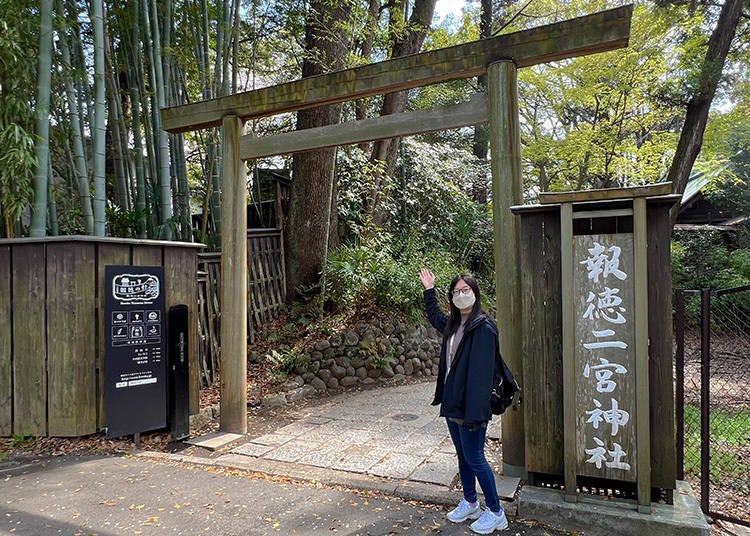
After having completed sightseeing and shopping around the castle park, consider sneaking away northwest of the main keep, to a tranquil hideaway with lesser crowds. Hotoku Ninomiya Shrine is a Shinto shrine located in the back corner of the Odawara Castle Park, established in 1894. The shrine honors Ninomiya Kinjiro, born in Odawara and known for his contributions to agricultural reform and moral teachings.
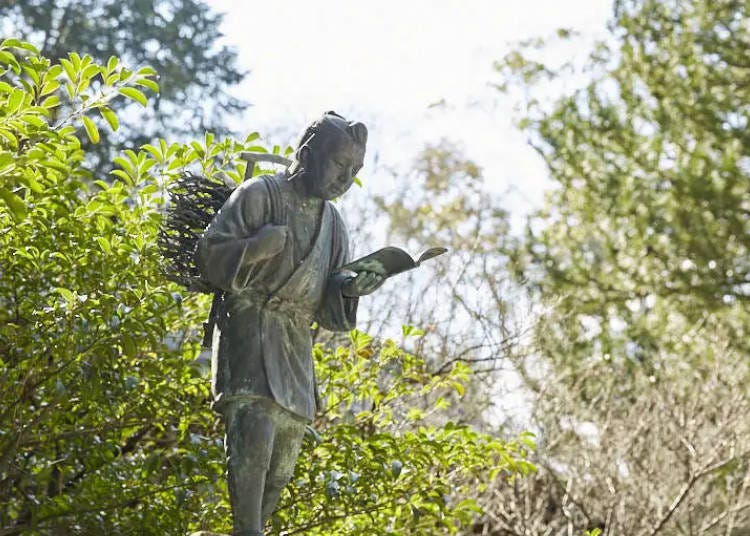
The shrine features a bronze statue depicting Kinjiro as a young boy carrying firewood while reading, symbolizing his dedication to self-education and community service. The grounds feature a café offering meals inspired by what Kinjiro ate in the Edo period, along with original goods for sale and facilities available for weddings and receptions.
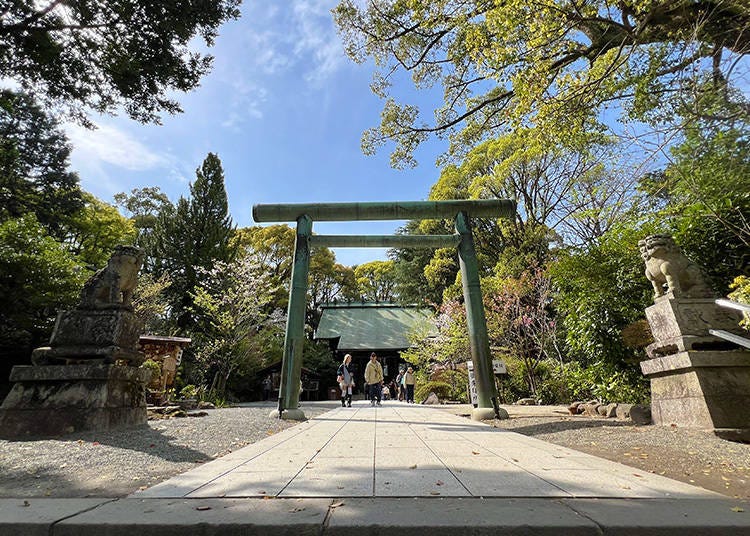
While this area is quieter than the Castle Park, Hotoku Ninomiya Shrine is a popular spot during cherry blossom season. On weekends, it is often lively with many visitors and events.
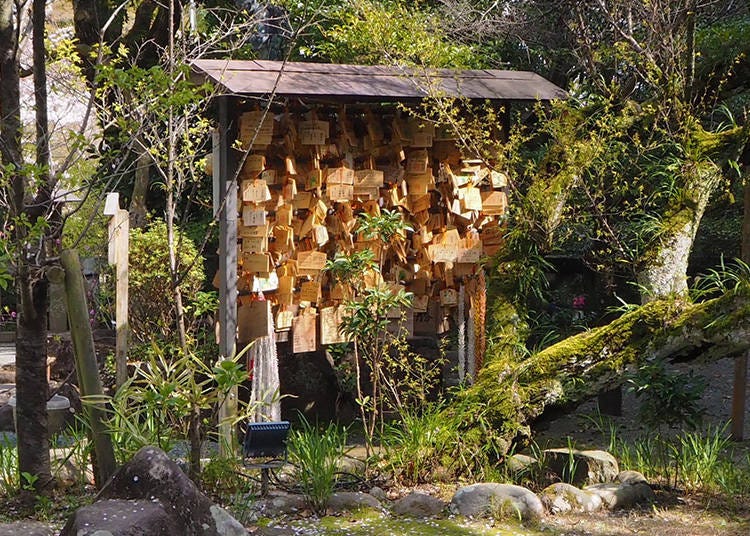
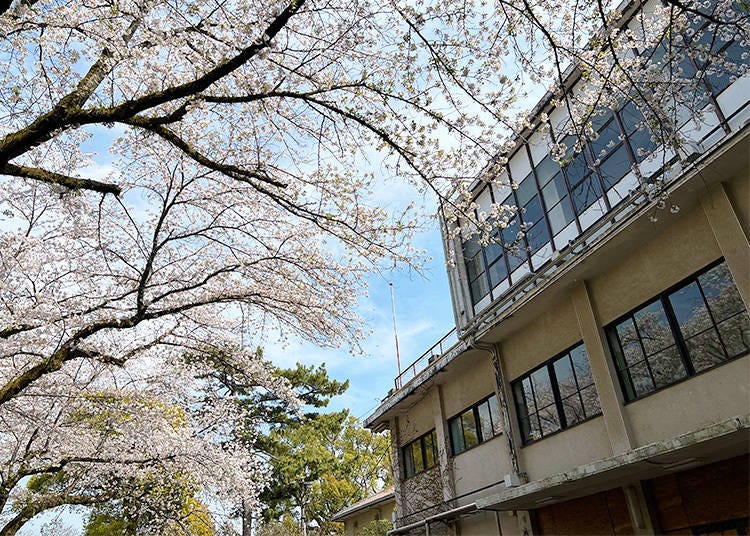
The cherry blossoms paired with the stunning views over the shrine offer a different charm than the castle park, a definite must-visit spot when you're in the area.
- Shrine Grounds Open
- Summer: 6 AM – 6 PM
- Winter: 6 AM – 5 PM - Omamori Counter
9 AM – 4 PM - Goshuin (Seal Stamps)
9 AM – 4 PM - Handwritten times:
・Weekdays: 10 AM – 3 PM
・Weekends/Holidays: 9:30 AM – 3:30 PM
Outside those times, pre-written goshuin are available.
-
Hotoku Ninomiya Shrine報徳二宮神社
- Address 8-10 Jonai, Odawara-shi, Kanagawa-ken 250-0014 (within the Odawara Castle Park)
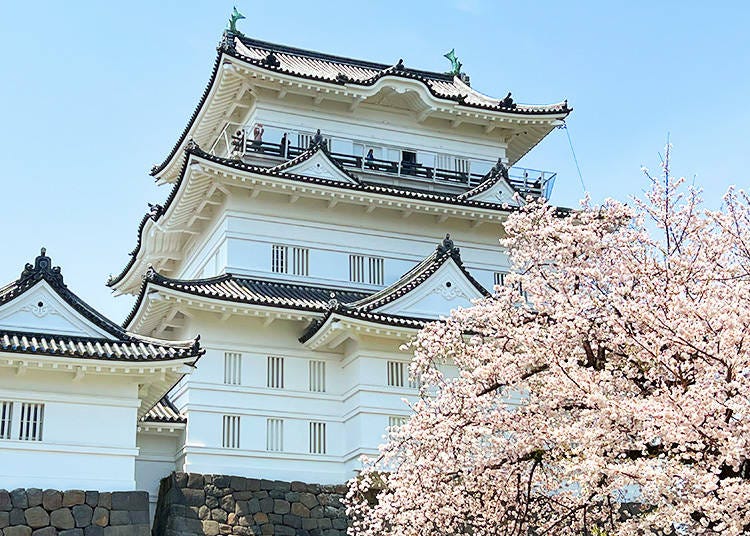
Whether you are on the hunt for the best cherry blossoms, or want to dig your teeth into the rich samurai history of the area, Odawara Castle is a fantastic destination in spring!
Cherry Blossom Forecast for 2025
In 2025, Tokyo’s cherry blossoms began to bloom around March 24, peaking on March 30. Due to swift changes in temperature, the blossoms held on well and were still in full bloom on April 8th, 2025, when we visited. In fact, flowers had just started falling off the trees, creating a beautiful sight as the snow-like petals danced around the castle grounds.
We make sure to update forecast information ahead of schedule, as well as during the blooming season. Make sure to follow our forecast updates to plan your trip perfectly:
Where to Stay in Odawara
-
 Perfect for a 1-night stay: Odawara Terminal Hotel (3 minutes from Odawara Station)
Perfect for a 1-night stay: Odawara Terminal Hotel (3 minutes from Odawara Station) -
 American-style Breakfast & Comfortable Work Space: Tenseien Odawara Station Annex (2 minutes from Odawara Station)
American-style Breakfast & Comfortable Work Space: Tenseien Odawara Station Annex (2 minutes from Odawara Station) -
 Traditional Japanese Inn: Ryokan Plum (3 minutes from Odawara Castle)
Traditional Japanese Inn: Ryokan Plum (3 minutes from Odawara Castle) -
 Perfect for families: THE VIEW Odawara shiro-no mieru hotel (7 minutes from Odawara Station)
Perfect for families: THE VIEW Odawara shiro-no mieru hotel (7 minutes from Odawara Station)
Recommended Side Trips
*This article was originally published in July 2025. Prices and services may change. Please refer to the official website for updated information.
*All prices mentioned in this article include tax.
The LIVE JAPAN editorial team is a multinational group made up of native editors who have lived in Japan for over five years and Japanese editors who love to travel. Together, we share the best of Japan, offering cultural insights, historical context, event updates, and travel-friendly deals, to support your journey every step of the way.
- Area
- Category
*Prices and options mentioned are subject to change.
*Unless stated otherwise, all prices include tax.
Popular Tours & Activitiess
Recommended places for you
-
Ad

A Tokyo Souvenir with Soul: The Handcrafted Leather of Bunkoya Oozeki
-
Ad

Okinawa Travel Troubles? Guide to the MCC Hotline for Illness and Weather Emergencies
-
Ad

Feeling Unwell While Traveling? HOTEL de DOCTOR 24 is Japan's Sole 24-Hour Online Medical Consultation Service
-

Best Things to Do and See Around Tokyo in September: Events and Festivals in Kanto
-
Ad

Just 2 Hours from Tokyo! Enjoy Ibaraki’s Breathtaking Ocean Views, Flowers & Autumn Leaves on Private Tours
-
Ad

Ohta’s Isan Gets a Refresh: Introducing the New Ohta’s Isan S and Ohta’s Isan <Sachet> S with Updated Packaging and Improved Benefits
Inspiration for Accommodations
-
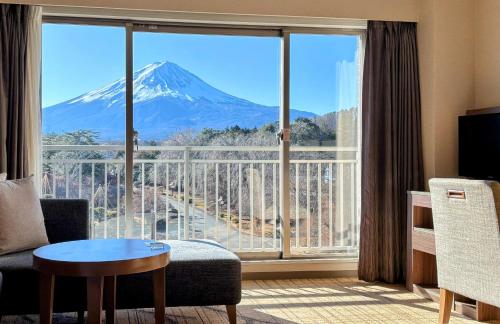
Enjoy Mt. Fuji from the Comfort of Your Room! Recommended Ryokan with Mt. Fuji View
-

Stay Near the Cherry Blossoms! Hotels for Cherry Blossom Viewing in Tokyo
-

Family-Friendly Hotels with Free Shuttle to Disneyland: Convenient Access for a Magical Stay
-

Top Ranked Hakone Hotels with Mt. Fuji View: Enjoy Stunning Scenery from Your Private Space
-
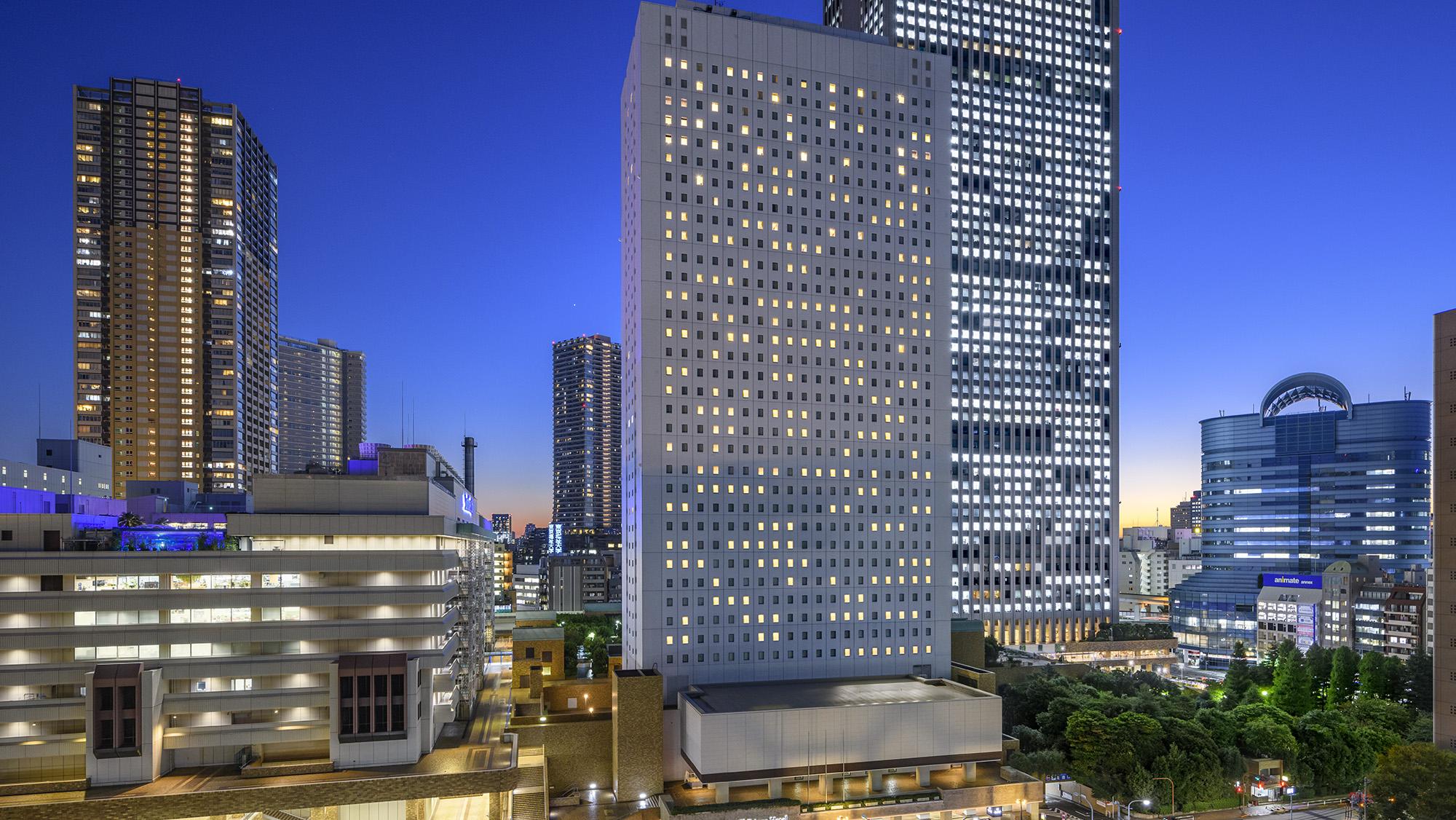
Convenient Tokyo Hotels with Airport Shuttle: Ideal for Families and Heavy Luggage
-

Stunning Tokyo Tower View Hotels: Enjoy Spectacular Scenery from Your Private Space
-

Convenient Asakusa Hotels with Kitchens: Ideal for Extended Family Visits
-

Experience Luxury: Hakone's 10 Best Five-Star Accommodations
-

Enjoy Mt. Fuji Autumn Leaves! Top Hotels Near the Popular Autumn Leaves Corridor
-

Experience Hakone Fall Foliage from Your Room with Stunning Views
-

Meiji Shrine (Meiji Jingu): Exploring the Sacred Sanctuary of Peace in Bustling Tokyo
-

Easy Day Trip from Tokyo! Ultimate Sightseeing Guide for Hakone & Lake Ashinoko!
-

What to Pack for Japan: 8 Essential Things for a Hassle-Free Trip
-

(Video) Walking Tour along Narita Omotesando - Quaint Historical Village near Narita Airport!
by: Victor Gonzalez
-

6 Fun Things to Do at Tokyo's World-Famous Tsukiji Outer Market!
-

Secrets to Shopping in Japan: Guide to Annual Sales in Japan & Where to Shop
by: Miyu Shimada
- #best ramen tokyo
- #what to buy in ameyoko
- #what to bring to japan
- #new years in tokyo
- #best izakaya shinjuku
- #things to do tokyo
- #japanese nail trends
- #what to do in odaiba
- #onsen tattoo friendly tokyo
- #daiso
- #best sushi ginza
- #japanese convenience store snacks
- #best yakiniku shibuya
- #japanese fashion culture
- #best japanese soft drinks



























